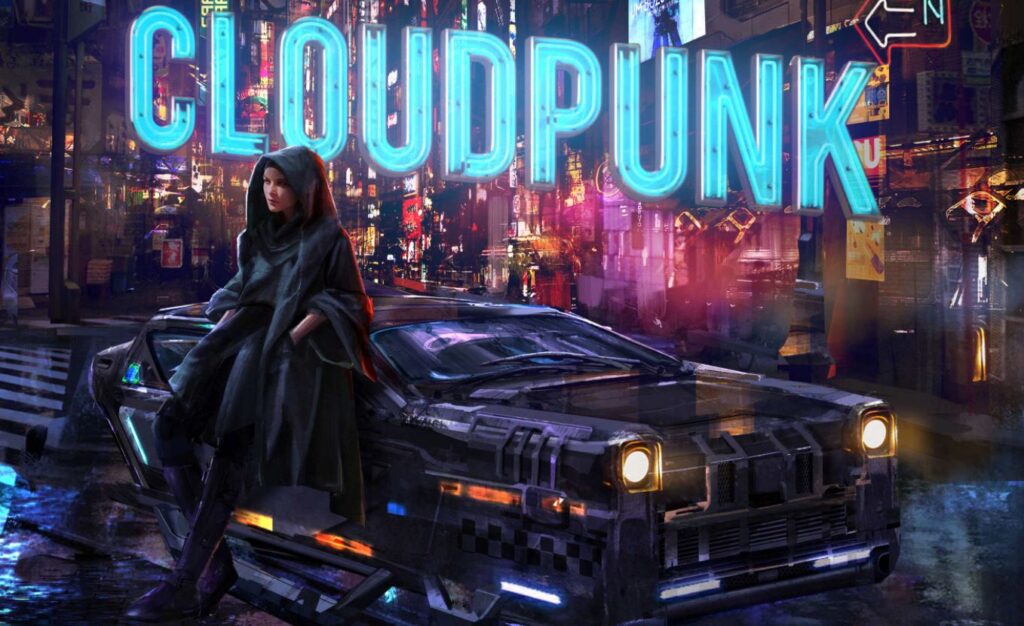Cloudpunk touches on gender and race with messy sci-fi allegories
The use of allegory is a given in the sci-fi genre — fiction can draw parallels to the present while keeping its distance in a speculative future to create its own story. But in a cyberpunk story like Cloudpunk, which comes from developer Ion Lands, the sci-fi allegory is a bit more honed and specific. Oppressive regimes, grimy urban settings, cybernetics, and a hard-boiled noir tone are tropes to be expected, and this narrative game has all of these elements checked off.
This story centers on Rania, new to the floating megacity of Nivalis, and moonlighting as a courier for the semi-illicit delivery company that serves as the namesake of the game. Cloudpunk depicts her full first night on the job, and what a night it is. Rania is a stranger in a strange land, and her deliveries, sidequests, and unexpected run-ins give her more of a taste of this city. She meets people of different backgrounds and cultures — her own status and history as an outsider affects how these other characters treat her, and in turn informs how she treats others.
It quickly becomes clear that Cloudpunk is trying to be forward-thinking with its allegories and commentary, with AI and androids becoming stand-ins for minorities, namely people of color and trans people. But despite apparently good intentions, the parallels and metaphors made become blurred and bungled together. In a way, this story is a demonstration on some of the fallacies of modern attempts at cyberpunk, with an aura of cynicism that is becoming tiresome.
An undeniable advantage of the cyberpunk subgenre is the vast catalog of visual inspirations to take advantage of. Neon cities might be considered cliche, but the expansive world of Nivalis is arresting, for the most part. More seasoned experts of cyberpunk could probably cite a litany of other sources, but I would still favorably compare it to both Blade Runner films. What sets Cloudpunk apart is the voxel art style — all of the characters, objects, and environments appear as 3D pixel art, while still retaining a ton of personality. It’s a great look, although admittedly unsettling if you zoom in on someone.
Gameplay primarily consists of you flying around in a hovercar, or a HOVA, and it’s a novelty that I very much enjoyed. Speeding through crowded highways can be fun and all, but going “off-road” and slaloming between tall structures and viewing the bright and rainy world from afar was on another level. Unfortunately, there’s not much else to it. You’ll follow waypoints, make deliveries, listen to mountains of exposition, and run on errands while on foot. There isn’t much skill involved except for reading the sometimes confusing map and having the common sense to not collide with every solid object you see. And the illusion of the city begins to wear off when you realize that all NPCs and cars are on autonomous predetermined patterns.
It doesn’t quite help that the console version performs poorly, with frame rate drops and hitches. There were also multiple times where NPCs would repeat dialogue sequences from earlier in the game, creating a bug where I’d be given the same objectives and waypoints again to never be completed, covering my screen with excessive HUD elements. But ultimately, the “game” part of this game is meant to take a backseat — you’re playing Cloudpunk for the narrative.
I wish that the voice performance for Rania was more convincing, as she’s a well-written and fleshed out character. Rania hails from the Eastern Peninsula, speaks Arabic, and used to be a musician. She’s a realist, but she has a spark of hope and determination that gets her through this unusual first night in the city. I enjoyed her growing relationship with Control, her Cloudpunk supervisor, but eventually found her frequent conversations with her dog AI Camus, which sounds less like a cyberpunk feature and more like a 1990s children’s movie premise, to be grating. The overall tone of Cloudpunk is surprisingly lighthearted, and you never quite feel the danger that the characters talk of out loud.
There are plenty of shady figures and quirky characters to encounter, such as Huxley, an android private investigator who eternally speaks as if he’s narrativing a film noir. But it was the brief brushes with side characters and NPCs who were a bit closer to the present that stick in the back of my mind, for better or worse. There’s Rory Alpha, a sexist shock jock with a podcast that gives his “Bro-Brothers” the chance to “finally” have their say (he even says “like and subscribe” at the end). There are the employees of Anderson Financial, named Mr. or Ms. Anderson, stuck in an eternal workday loop and workplace gender roles. Dynamic Simpson is a musical producer trying to appropriate cultural imagery from Rania for a music video, and Comrade Bop is an activist android stuck protesting solely in rhyme.
All of this seems to exemplify a “the more things change, the more they stay the same” vision of the future. You can argue that this is always the case with sci-fi allegories, but the way Cloudpunk presents these characters and touches on modern social issues is far too on the nose and wink-wink-nudge-nudge. Perhaps the one moment with nuance is with Rania’s android neighbor Evelin; when Rania tries to be performative as an ally, Evelin responds with a terse “Please do not tell me how to label myself.”
Cloudpunk’s biggest card to play is the use of androids as a stand-in for every marginalized group, and it is a shaky foundation to build on. You get little tidbits of world-building, such as a flyer for an android dating service, but you’re confused if it’s for androids dating androids or humans who want to date androids — it feels less like commentary on romance in the future and more like a Futurama gag. And then there are mentions of some sort of previous “civil rights” movement for androids, and a brief namedrop of an “android equality act.” “You’re all allowed to present any gender you want, or reject gender altogeher,” Rania tells Ms. Anderson. And later in the game, you pick up a disgruntled co-worker who rants about androids putting ordinary humans “on the margins” by “breeding them out of existence.”
One of the most obvious cases of allegory is Mr. Octavius-Butler, an android who reaches high status by marrying a human, accumulating wealth, and being “human-passing.” He and his wife are exaggeratedly elitist and snobby, and the parallel of one disconnected from their marginalized demographic due to their status and wealth is quite blatant. But the most clear-cut allegorical character is from a character named Pete, who is clearly meant to represent a trans narrative. Pete is an android who doesn’t feel right with his body, and is trying to wear “dermis” to replicate human skin and appear organic. He is met with mockery, fear, and usage of his android “deadname” of “Patchwork.” He hides in an alley, asking Rania to retrieve dermis, which acts as the story’s equivalent to hormone replacement therapy.
“Dermis is expensive. Do you… do you ever consider just living as an android?” Rania asks Pete. “Never,” Pete responds. I don’t feel like an android. My body feels… wrong. I want to have skin.”
Video games are already lacking in trans narratives, and it’s difficult to say if Cloudpunk helps to move the needle at all. These storylines feel brushed off as sidequests, and combining the experiences of queer folx and racial minorities into one stand-in fictional group feels slapdash. The plights of these different marginalized groups seem smaller and less violent through this fictional lens compared to how it is in real life. Instead of leaning more into a future of trans acceptance, we go back to a cynical “more things change, more they stay the same” attitude for the sake of a hackneyed metaphor.
Cloudpunk is not the first cyberpunk game to go this route, nor will it be the last — it won’t even be the first or last of its kind from this year alone. It would be nice, for once, if one of these speculative futures can skip the allegory and just acknowledge and respect the fact that trans people are and always will be real and present.







